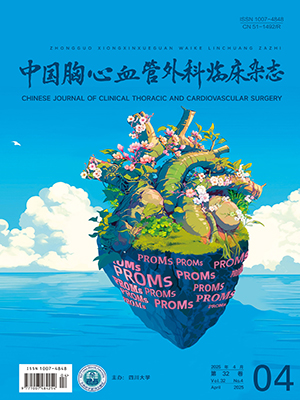| 1. |
Vahanian A, Beyersdorf F, Praz F, et al. 2021 ESC/EACTS guidelines for the management of valvular heart disease. Eur Heart J, 2022, 43(7): 561-632.
|
| 2. |
Bowdish ME, D'Agostino RS, Thourani VH, et al. STS Adult Cardiac Surgery Database: 2021 update on outcomes, quality, and research. Ann Thorac Surg, 2021, 111(6): 1770-1780.
|
| 3. |
D'Ascenzo F, Conrotto F, Giordana F, et al. Mid-term prognostic value of coronary artery disease in patients undergoing transcatheter aortic valve implantation: A meta-analysis of adjusted observational results. Int J Cardiol, 2013, 168(3): 2528-2532.
|
| 4. |
Sasaki Y, Hirai H, Hosono M, et al. Adding coronary artery bypass grafting to aortic valve replacement increases operative mortality for elderly (70 years and older) patients with aortic stenosis. Gen Thorac Cardiovasc Surg, 2013, 61(11): 626-631.
|
| 5. |
Bajaj A, Pancholy S, Sethi A, et al. Safety and feasibility of PCI in patients undergoing TAVR: A systematic review and meta-analysis. Heart Lung, 2017, 46(2): 92-99.
|
| 6. |
Alperi A, Mohammadi S, Campelo-Parada F, et al. Transcatheter versus surgical aortic valve replacement in patients with complex coronary artery disease. JACC Cardiovasc Interv, 2021, 14(22): 2490-2499.
|
| 7. |
Tarus A, Tinica G, Bacusca A, et al. Coronary revascularization during treatment of severe aortic stenosis: A meta-analysis of the complete percutaneous approach (PCI plus TAVR) versus the complete surgical approach (CABG plus SAVR). J Card Surg, 2020, 35(8): 2009-2016.
|
| 8. |
Abugroun A, Osman M, Awadalla S, et al. Outcomes of transcatheter aortic valve replacement with percutaneous coronary intervention versus surgical aortic valve replacement with coronary artery bypass grafting. Am J Cardiol, 2020, 137: 83-88.
|
| 9. |
牛毅菲, 贺宇, 黄琼, 等. 经皮冠状动脉介入治疗联合经导管主动脉瓣置换术治疗冠心病合并主动脉瓣疾病的临床疗效. 中国心血管病研究, 2023, 21(3): 263-268.
|
| 10. |
王墨扬, 宋光远, 张倩, 等. "一站式"经皮冠状动脉介入治疗+经导管主动脉瓣置换术的临床应用. 中国循环杂志, 2021, 36(9): 6.
|
| 11. |
Bach DS, Siao D, Girard SE, et al. Evaluation of patients with severe symptomatic aortic stenosis who do not undergo aortic valve replacement: The potential role of subjectively overestimated operative risk. Circ Cardiovasc Qual Outcomes, 2009, 2(6): 533-539.
|
| 12. |
Dewey TM, Brown DL, Herbert MA, et al. Effect of concomitant coronary artery disease on procedural and late outcomes of transcatheter aortic valve implantation. Ann Thorac Surg, 2010, 89(3): 758-767.
|
| 13. |
Venturi G, Pighi M, Lunardi M, et al. Contrast-induced nephropathy in patients undergoing staged versus concomitant transcatheter aortic valve implantation and coronary procedures. J Am Heart Assoc, 2021, 10(15): e020599.
|
| 14. |
Altibi AM, Ghanem F, Hammad F, et al. Clinical outcomes of revascularization with percutaneous coronary intervention prior to transcatheter aortic valve replacement: A comprehensive meta-analysis. Curr Probl Cardiol, 2022, 47(11): 101339.
|
| 15. |
Tanaka A, Jabbour RJ, Testa L, et al. Incidence, technical safety, and feasibility of coronary angiography and intervention following self-expanding transcatheter aortic valve replacement. Cardiovasc Revasc Med, 2019, 20(5): 371-375.
|
| 16. |
Nai Fovino L, Scotti A, Massussi M, et al. Incidence and feasibility of coronary access after transcatheter aortic valve replacement. Catheter Cardiovasc Interv, 2020, 96(5): E535-E541.
|
| 17. |
Ochiai T, Chakravarty T, Yoon SH, et al. Coronary access after TAVR. JACC Cardiovasc Interv, 2020, 13(6): 693-705.
|




